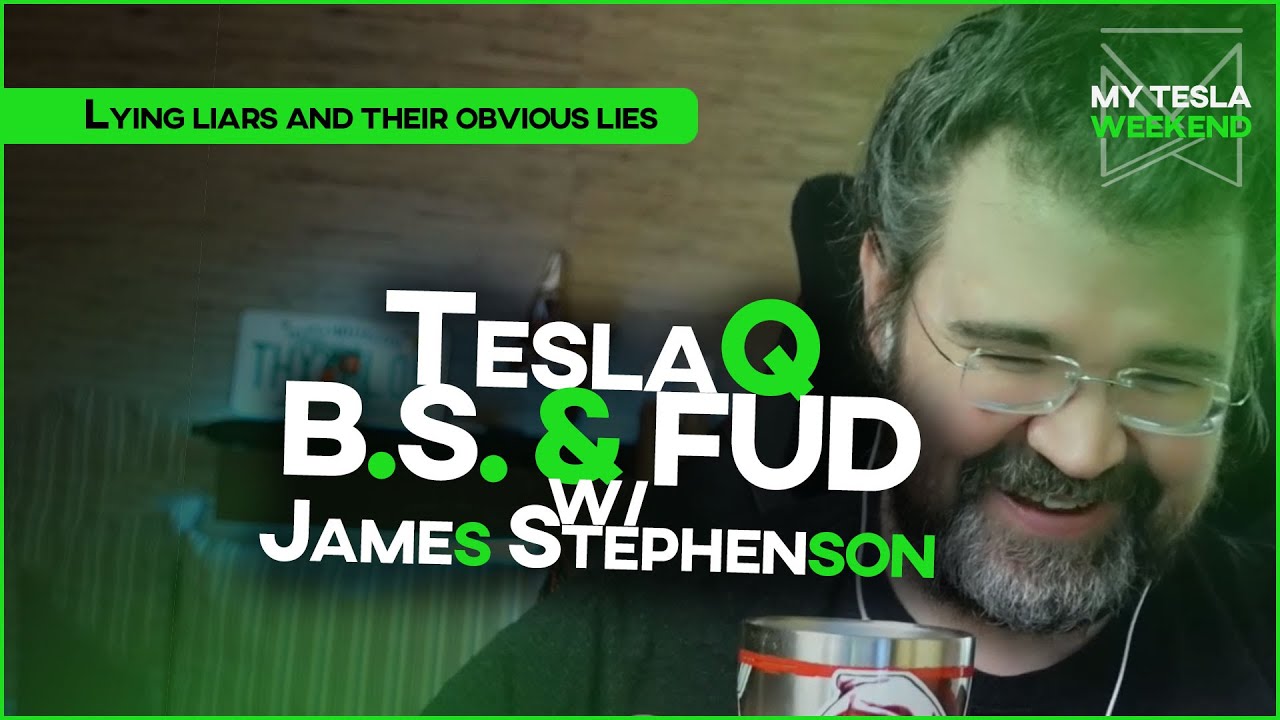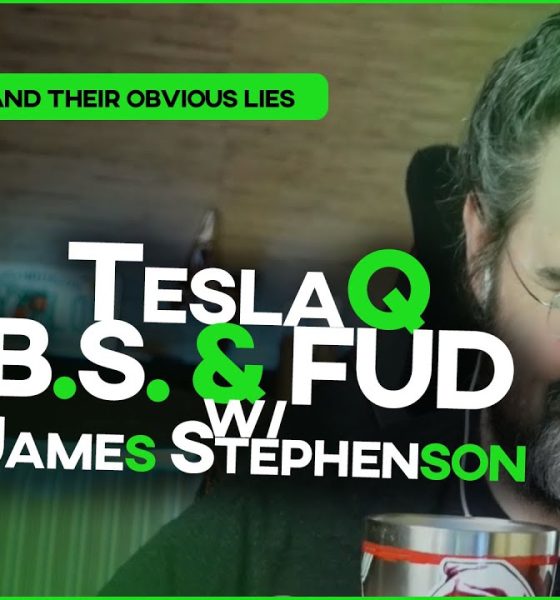

News
MyTeslaWeekend & James Stephenson debunk a lot of nonsense surrounding Tesla
MyTeslaWeekend and James Stephenson shared a deep dive into the nonsense and misinformation surrounding Tesla. And they debunked each one. There always seems to be Tesla critics who take things a bit too far. MyTeslaWeekend didn’t hold back. In the video’s description, he said,
“These guys use some really dishonest math. They deduct from one side without accounting for the other. They count something for GM or Stellantis, but not Tesla. They move numbers between columns as if that’s how accounting works. They’re lying liars. Not James’ words, but mine.”
Some of the topics they covered included zero-emissions vehicles (ZEV) credits not being taxpayer money, General Motors (GM) only selling 26 Evs in the last quarter of 2021, Tesla CEO Elon Musk’s actual compensation accounting, the pump and dump myth, and so much more.
ZEV Credits Are Not Taxpayer Money
James pointed out that some people seem to think ZEV credits are taxpayer money when this is not the case.
“Some people get the wrong-headed notion that regulatory credits are a stipend from the government; that governments are giving you taxpayer money. And that is not what’s going on at all. The money you’re making is from selling to your competitors who did not produce enough electric vehicles to comply with applicable law.”
The money, he added is for competitors who don’t want to pay fines to the government for non-compliance.
GM Only Sold 26 Evs In Q4 2021
Despite President Biden’s claim that GM is the EV leader, the automaker only sold 26 EVs in Q4 2021.
“In Q4 of 2021, General Motors sold 26 electric vehicles. They sold 25 Volts and they sold one electric Hummer, I believe, to Mary Barra. I think she was the buyer of the one electric Hummer.”
Tesla, he added, sold over 300,000 electric vehicles.
Elon Musk’s Compensation
Elon Musk as CEO of Tesla doesn’t take a salary and James added that he doesn’t get any cash bonus.
“Most CEOs do have either or both of those as part of their compensation package.”
“What Elon said was, ‘hey if I can’t grow the revenue and the market capitalization of this company, the value of people’s investments in this company by tremendous amounts, you don’t owe me anything. I’ll make zero dollars if I can’t do those things.”
James further explained how the gap accounting treatment works.
“As Elon made progress towards achieving those aggressive goals that I just outlined, Tesla had to record expense relative to the proportion to the twelves tranches that Elon was making progress towards achieving.”
“This is not widely understood. So, another thing that we saw in Q1 of 2022, the most recently reported quarter was ‘Tslaq’ crying foul over the reduction in SG&A year-over-year”
He pointed out that this group, ‘Tslaq’ which is mostly responsible for a lot of the misinformation against Tesla, said that last year, the number was larger than this year. So by the logic of this group, Tesla must be committing fraud.
“‘It has to be fraud. There’s no way your SG&A could have come down by that much year-over-year.’ Well, it’s because a year ago, Elon was still making tons of progress towards achieving these market cap and revenue and even milestones. And this year, the work’s done already. It was almost completely achieved by the end of 2021. So there’s almost nothing left to pay against it.”
‘Elon Musk is a Pump and Dump’ Myth
MyTeslaWeekend shared his biggest pet peeve that he sees all the time which is the constant claim that Elon Musk is nothing but a pump and dump. James shared his thoughts.
“He owns more shares now than he did a year ago or two years ago. And he’s probably going to buy more shares if he can extricate himself from the Twitter situation. So, he still owns more Twitter stock than anybody else does right now. Far more than the people on Twitter’s board combined.”
Elon Musk is also often accused of pumping and dumping Dogecoin however he hasn’t sold his Doge. In fact, he’s recently reaffirmed his support of Doge. In addition to Doge, and Tesla, some critics have claimed Elon has pumped and dumped SpaceX stock and MyTeslaWeekend pointed out that this isn’t a publicly traded stock.
Debunking the nonsense is something that is done on a regular basis and the video, I think is a gem in the treasure box. You can watch the full video below.

Elon Musk
Elon Musk’s X will start using a Tesla-like software update strategy
The initiative seems designed to accelerate updates to the social media platform, while maintaining maximum transparency.

Elon Musk’s social media platform X will adopt a Tesla-esque approach to software updates for its algorithm.
The initiative seems designed to accelerate updates to the social media platform, while maintaining maximum transparency.
X’s updates to its updates
As per Musk in a post on X, the social media company will be making a new algorithm to determine what organic and advertising posts are recommended to users. These updates would then be repeated every four weeks.
“We will make the new 𝕏 algorithm, including all code used to determine what organic and advertising posts are recommended to users, open source in 7 days. This will be repeated every 4 weeks, with comprehensive developer notes, to help you understand what changed,” Musk wrote in his post.
The initiative somewhat mirrors Tesla’s over-the-air update model, where vehicle software is regularly refined and pushed to users with detailed release notes. This should allow users to better understand the details of X’s every update and foster a healthy feedback loop for the social media platform.
xAI and X
X, formerly Twitter, has been acquired by Elon Musk’s artificial intelligence startup, xAI last year. Since then, xAI has seen a rapid rise in valuation. Following the company’s the company’s upsized $20 billion Series E funding round, estimates now suggest that xAI is worth tens about $230 to $235 billion. That’s several times larger than Tesla when Elon Musk received his controversial 2018 CEO Performance Award.
As per xAI, the Series E funding round attracted a diverse group of investors, including Valor Equity Partners, Stepstone Group, Fidelity Management & Research Company, Qatar Investment Authority, MGX, and Baron Capital Group, among others. Strategic partners NVIDIA and Cisco Investments also continued support for building the world’s largest GPU clusters.
News
Tesla FSD Supervised wins MotorTrend’s Best Driver Assistance Award
The decision marks a notable reversal for the publication from prior years, with judges citing major real-world improvements that pushed Tesla’s latest FSD software ahead of every competing ADAS system.

Tesla’s Full Self-Driving (Supervised) system has been named the best driver-assistance technology on the market, earning top honors at the 2026 MotorTrend Best Tech Awards.
The decision marks a notable reversal for the publication from prior years, with judges citing major real-world improvements that pushed Tesla’s latest FSD software ahead of every competing ADAS system. And it wasn’t even close.
MotorTrend reverses course
MotorTrend awarded Tesla FSD (Supervised) its 2026 Best Tech Driver Assistance title after extensive testing of the latest v14 software. The publication acknowledged that it had previously criticized earlier versions of FSD for erratic behavior and near-miss incidents, ultimately favoring rivals such as GM’s Super Cruise in earlier evaluations.
According to MotorTrend, the newest iteration of FSD resolved many of those shortcomings. Testers said v14 showed far smoother behavior in complex urban scenarios, including unprotected left turns, traffic circles, emergency vehicles, and dense city streets. While the system still requires constant driver supervision, judges concluded that no other advanced driver-assistance system currently matches its breadth of capability.
Unlike rival systems that rely on combinations of cameras, radar, lidar, and mapped highways, Tesla’s FSD operates using a camera-only approach and is capable of driving on city streets, rural roads, and freeways. MotorTrend stated that pure utility, the ability to handle nearly all road types, ultimately separated FSD from competitors like Ford BlueCruise, GM Super Cruise, and BMW’s Highway Assistant.
High cost and high capability
MotorTrend also addressed FSD’s pricing, which remains significantly higher than rival systems. Tesla currently charges $8,000 for a one-time purchase or $99 per month for a subscription, compared with far lower upfront and subscription costs from other automakers. The publication noted that the premium is justified given FSD’s unmatched scope and continuous software evolution.
Safety remained a central focus of the evaluation. While testers reported collision-free operation over thousands of miles, they noted ongoing concerns around FSD’s configurable driving modes, including options that allow aggressive driving and speeds beyond posted limits. MotorTrend emphasized that, like all Level 2 systems, FSD still depends on a fully attentive human driver at all times.
Despite those caveats, the publication concluded that Tesla’s rapid software progress fundamentally reshaped the competitive landscape. For drivers seeking the most capable hands-on driver-assistance system available today, MotorTrend concluded Tesla FSD (Supervised) now stands alone at the top.
News
Elon Musk’s Grokipedia surges to 5.6M articles, almost 79% of English Wikipedia
The explosive growth marks a major milestone for the AI-powered online encyclopedia, which was launched by Elon Musk’s xAI just months ago.

Elon Musk’s Grokipedia has grown to an impressive 5,615,201 articles as of today, closing in on 79% of the English Wikipedia’s current total of 7,119,376 articles.
The explosive growth marks a major milestone for the AI-powered online encyclopedia, which was launched by Elon Musk’s xAI just months ago. Needless to say, it would only be a matter of time before Grokipedia exceeds English Wikipedia in sheer volume.
Grokipedia’s rapid growth
xAI’s vision for Grokipedia emphasizes neutrality, while Grok’s reasoning capabilities allow for fast drafting and fact-checking. When Elon Musk announced the initiative in late September 2025, he noted that Grokipedia would be an improvement to Wikipedia because it would be designed to avoid bias.
At the time, Musk noted that Grokipedia “is a necessary step towards the xAI goal of understanding the Universe.”
Grokipedia was launched in late October, and while xAI was careful to list it only as Version 0.1 at the time, the online encyclopedia immediately earned praise. Wikipedia co-founder Larry Sanger highlighted the project’s innovative approach, noting how it leverages AI to fill knowledge gaps and enable rapid updates. Netizens also observed how Grokipedia tends to present articles in a more objective manner compared to Wikipedia, which is edited by humans.
Elon Musk’s ambitious plans
With 5,615,201 total articles, Grokipedia has now grown to almost 79% of English Wikipedia’s article base. This is incredibly quick, though Grokipedia remains text-only for now. xAI, for its part, has now updated the online encyclopedia’s iteration to v0.2.
Elon Musk has shared bold ideas for Grokipedia, including sending a record of the entire knowledge base to space as part of xAI’s mission to preserve and expand human understanding. At some point, Musk stated that Grokipedia will be renamed to Encyclopedia Galactica, and it will be sent to the cosmos.
“When Grokipedia is good enough (long way to go), we will change the name to Encyclopedia Galactica. It will be an open source distillation of all knowledge, including audio, images and video. Join xAI to help build the sci-fi version of the Library of Alexandria!” Musk wrote, adding in a later post that “Copies will be etched in stone and sent to the Moon, Mars and beyond. This time, it will not be lost.”








